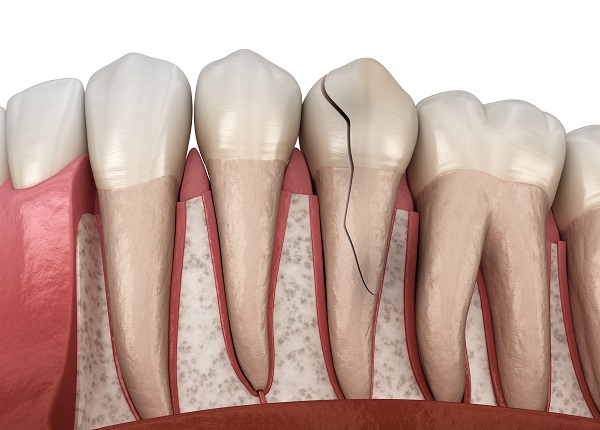Dental Treatment Options for a Cracked Tooth

Since every tooth plays an important role, saving a cracked tooth is essential to a healthy mouth. Even if a simple crack occurs, undergoing treatment promptly is necessary. Keep reading to learn more about cracked tooth treatment from a dentist.
What a cracked tooth means
Learning that a cracked tooth can potentially be a serious dental health issue is important. While a minor crack may not be a pressing issue, moderate or major cracks often require some form of dental treatment in order to repair the tooth. Common causes for experiencing a cracked tooth include grinding, clenching, chewing on ice, being in an auto or sports accident and improper oral care.
According to the American Dental Association, tiny cracks are common and usually do not cause problems, which is why regular dental checkups are important as they allow a dentist to diagnose and treat problems in the early stage.
Treating a cracked tooth
The list below includes some of the more common dental treatment options dentists use to treat a cracked tooth. When it comes to which option a dental patient will need, it depends on how severe the crack is.
Dental bonding
Dental bonding is a treatment option that is often used to treat cracked teeth. This treatment procedure uses a tooth-colored composite resin material to repair the crack. An experienced dentist will carefully attach the bonding to the area of the tooth that is in need of repair and then smooth and polish the bonding material so it will blend in with the rest of the teeth. Bonding not only repairs a cracked tooth, but it also allows the tooth to once again be cosmetically pleasing.
Dental veneers
Dental veneers are often used to treat cracked teeth that are located in the front of the mouth. Veneers are used for cosmetic reasons and because they are custom-made for every patient, dentists can create them for patients to repair and cover up any cracks in their front teeth. This treatment option is typically only reserved for treating minor cracks, as veneers are thin porcelain shells that are placed over a patient's teeth with a goal of fixing minor tooth problems.
Dental crowns
Dental crowns are often used to treat moderate to major cracks in teeth in the back of the mouth. Since it is possible for dental patients who have a crack in one of their back teeth to worsen the crack by the simple act of chewing food, sometimes it is necessary to give the tooth more strength so it does not break all the way. A crown is placed directly over the tooth, allowing it once again to be both strong and durable.
Treat a cracked tooth
The way a dentist treats a cracked tooth lies heavily on the reason the crack occurred, as well as how severe it is. To determine both, a dentist will need to carefully evaluate the tooth. Reach out today to get started with treatment.
Are you considering cracked tooth treatment in the Culver City area? Get more information at https://www.culvercitydental.com.
Check out what others are saying about our dental services on Yelp: Cracked Tooth Culver City, CA.
Recent Posts
Many dentists recommend implants to patients who want natural-looking replacement teeth. This review discusses why many dentists consider implant dentistry to be a great way to replace missing teeth.The following are some important to know about implant dentistry for teeth replacement, including what implant dentistry actually is, the advantages of treatment over alternative solutions, and…
Dental patients who are planning a visit to an implant dentist may be unfamiliar with the details regarding implants. It is crucial to learn as much information as possible before scheduling an appointment for this surgical procedure.A dental implant is a common permanent tooth replacement option that can be highly beneficial to a patient’s health…
Dental implant surgery is one of the most reliable and long-lasting ways to replace missing teeth. However, since this surgery involves inserting an artificial tooth root into the jawbone, it almost always causes some amount of pain. Before undergoing this surgery, many dental patients are worried about the level of pain they may experience afterward…
Are you in the market for a new cosmetic dentist? This type of dental professional is a fantastic resource when you want to adjust how your smile looks and functions. Cosmetic dentists undergo general dentistry training to properly treat patient's teeth and gums. They can make your smile more aesthetically appealing while also ensuring that…


